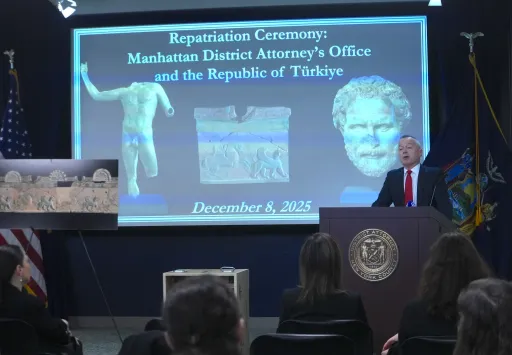By Mazhun Idris
If wisdom, beauty, myth and legend needed a botanic reference, Adansonia digitate, or the grand old baobab tree that towers over the savannahs of sub-Saharan Africa and its dry scrublands, might have made the cut.
A medium-to-large deciduous tree native to Africa and Australia, baobab bears the hallmarks of African climate, ancestry, and belief systems.
It's a tree of life in many ways, encompassing in its girth and spread all the branches of African anthropology steeped in science and myth.
According to the United Nations Convention to Combat Desertification, a baobab tree "can live up to 3,000 years, growing to 50 meters in circumference, and reach up to 30 meters high."
With a genetic diversity of nine species, six of which survive only in the African island of Madagascar, the baobab remains a subject of study and symbolism.
Among the world's iconic specimens of this intriguing gift of nature are the Sagole Baobab in South Africa, a Guinness world record holder.
Baobab is called Kuka in the Hausa language, Reniala in Malagasy, Mbuyu in Swahili, Gouye gui in Wolof, and Zelo in Lingala.
In folklore and pop culture, baobab is also called the upside-down tree because it appears to stand upended, as though its roots are sticking up in the air.
Another name, a less common one, is "cream of Tartar tree" — a reference to the baobab's pod, whose pulp contains citric and tartaric acids sour enough to be used as a milk-curdling agent, and a substitute for cream of Tartar, or potassium bitartrate used in cooking, baking and winemaking.
Gradual disappearance
Baobab is an extraordinary tree that thrives in urban, rural and forest environments. It is among the largest and longest-living trees in the world.
From Madagascar, South Africa and Zimbabwe to Senegal, DRC and Nigeria, picturesque groves of baobabs adorn the African landscape.
Scientifically, despite its soft wood, baobab has been proven to be fire-resistant. "Unless dead and dried off, baobab wood doesn't burn when ignited," Dr Mustapha Karkarna, a forest management expert at Nigeria's Bayero University Kano, tells TRT Afrika.
"The presence of baobab is an archaeological testimony to human settlement, also having multiple uses in medicine and craft.
Ecologically, it is treasured, which is why humans rarely fell a baobab tree. Birds love the tree for the safety it provides to their nests," he says.
But Garba Sani, a video documentarian, sounds a warning. In northern Nigeria, the baobab tree's size is causing its gradual disappearance from urban streets.
"Given its remarkably wide trunk, baobab is considered a space-wasting tree in terms of real estate," he says.
Sani decries how new land developers are quick to cut down huge baobabs, resulting in their shrinking presence cities.
Nyasha Chibanda, a Zimbabwe-born international development expert living in South Africa's Pretoria, makes a different observation.
"In Masvingo province, eastern Zimbabwe, baobabs grow mostly in rural areas with a wide expanse of open areas. Dwellers see no reason to cut them down."
Multi-purpose
Besides being a cultural symbol of Africa, baobab's propagation in Africa remains a priority because its products are essential for shelter, food, nutrition, and healing.
Unlike other giant species, these trees are part of residential compounds as their roots go downward instead of protruding out to damage foundations of buildings.
Abdulkadir Musa, a retired teacher in Giade town of Bauchi State in northeast Nigeria, points out how baobab's importance in the region's ecology transcends its unique appearance.
Traditional beliefs
"Baobab leaves are used as vegetable or powdered as a soup ingredient. It is also useful as fodder. Its seeds are roasted, and the fruit pulp is eaten raw or made into milk, porridge, juice, or jam. The tree bark is used as fibre for weaving ropes, baskets, and roofing," Musa tells TRT Afrika.
From farmlands to housing, baobab helps against soil erosion, and farmers don't see any harm in the tree's canopy becoming an invasive shade over plantations.
Sani mentions that in Hausa land, names of some places owe their origin to an existing or defunct baobab tree.
"In ancient Kano city, you have places like Kuka Bulukiya and Kuka Uku. Then there is Kukar Atillo in Nahuce town of Toro, Jigawa State," he says.
In the realm of African cultures, baobab is a ubiquitous presence, and some say pervasive. It is appreciated in some communities for its traditional use in treating diseases.
Conversely, baobab is also culturally infamous in some parts as a tree with sinister elements.
Some African religions associate the species with primitive divination such as ancestor worship, supplication, aliens, djinn, and spirits. In some communities, baobab is regarded as an "out-of-town tree".
Climate resilience
Pre-Islamic Hausa culture deems baobab as a coven of djinns, and children are warned against climbing or playing around the tree for danger of possession by spirits. The legendary Bori cult of Hausa animism features baobab in many of its practices.
The visual image of an imposing baobab tree is that of an ancient sentinel. The tree may look dead after shedding its leaves, but it quickly springs back to life with glossy, edible leaves and glorious fruits.
The climate resilience of a baobab allows it to thrive. Even when felled on its side, it continues to survive if a few roots are sticking to the ground.
"In the trunk of a baobab, there is no separation between the phloem and xylem; hence its capacity for water conservation," says Dr Mustapha Karkarna, former Kano State coordinator of the Nigerian national forest resource survey.
Then there are hollowed-out baobab trees whose massive trunks form caves and holes where reptiles, rodents and birds take shelter.
According to Dr Karkarna, “hollow trunks in baobab trees are caused by fungal diseases that damage the stem, not anything supernatural".
Dr Karkarna believes the primary factor in the mystification of baobab is the fact that these trees are some of the oldest living plants in the world.
One baobab tree may be older than the oldest person in an entire community. Thus, they are considered witnesses to the past, and have stories to tell about a community's history.
As the tree outgrows generations, it assumes a symbol of longevity and wisdom, making people make personal interpretations such as a cemetery of ancestral spirits. The tree is exploited in legends and fables, where it is sometimes featured as an evil shrine.
The one potent threat to baobab's existence despite its importance in the continent's ecology and diverse cultures is a rapidly expanding urban skyline and the preference of exotic plants over African natal species.
But as the German philosopher Friedrich Nietzsche said, to live is to suffer; to survive is to find some meaning in the suffering.
Nothing perhaps epitomises this better than the ancient baobab standing testimony to millennia of civilisational growth and depredation.
























